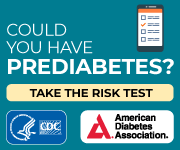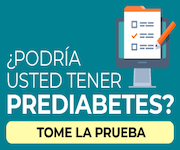
Stop Prediabetes. Take the Test. Know Your Risk.

Stop Prediabetes by taking the Prediabetes Risk Test created by the Centers for Disease Control and Prevention (CDC).

PREDIABETES
Prediabetes is a serious yet often reversible condition where blood sugar levels are above normal but not elevated enough for type 2 diabetes. This usually occurs because the body is not making enough insulin or insulin is not working as effectively. Insulin is a hormone needed to convert sugar, starches, and other food to energy for daily life. Some people may have no symptoms or have vague symptoms of prediabetes for years without knowing they have it. Having prediabetes can increase a person’s risk for type 2 diabetes, heart disease, and stroke. Almost 40% of adults, or about 2.6 million adults, in Georgia fall within this range.
Watch the CDC’s video: What is Prediabetes?

Without intervention, prediabetes can lead to type 2 diabetes. Type 2 diabetes is a condition where cells do not respond normally to insulin. This is called insulin resistance. The pancreas makes more insulin to try to get cells to respond. Eventually, the pancreas cannot keep up, and blood sugar rises, setting the stage for prediabetes and type 2 diabetes. High blood sugar is damaging to the body and can cause other serious health problems, such as heart disease, vision loss, and kidney disease.
It is important to know your risk for prediabetes and take the test. You can have prediabetes for years but have no clear symptoms. It often goes undetected until serious health problems, such as type 2 diabetes, show up. It is important to talk to your doctor about getting your blood sugar tested if you have any of the risk factors for prediabetes:
- Being overweight
- Being 45 years or older
- Having a parent, brother, or sister with type 2 diabetes
- Being physically active less than three times a week
- Ever having gestational diabetes (diabetes during pregnancy) or giving birth to a baby who weighed more than nine pounds
- Having polycystic ovary syndrome
Take the Prediabetes Risk Test by the CDC.
Race and ethnicity are also a factor: African Americans, Hispanic or Latino Americans, American Indians, Pacific Islanders, and some Asian Americans are at higher risk for developing prediabetes and type 2 diabetes.
Type 2 diabetes can be prevented through lifestyle changes such as diet, exercise, and weight loss.
Stop Prediabetes. Take the Prediabetes Risk Test by the CDC.
TAKE ACTION
Watch the CDC’s video: You’ve got Prediabetes. What now?
The CDC-led National Diabetes Prevention Lifestyle Change Program (DPP) can help people with prediabetes make lifestyle changes to prevent or delay the onset of type 2 diabetes and other serious health problems. Through the National DPP, you can lower your risk of developing type 2 diabetes by as much as 58% (or 71% if you’re over age 60). Highlights include:
Working with a trained coach to make realistic, lasting lifestyle changes
Discovering how to eat healthy and add more physical activity into your day
Finding out how to manage stress, stay motivated and solve problems that can slow your progress
Getting support from people with similar goals and challenges
Find a DPP program near you: https://nccd.cdc.gov/DDT_DPRP/Programs.aspx
Watch the CDC’s video: Reversing Prediabetes with the National Diabetes Prevention Program
MORE ABOUT PREDIABETES MANAGEMENT
Diabetes is a chronic (long-lasting) condition in which the body does not produce or properly use insulin. Insulin is a hormone that is needed to convert sugar, starches, and other food to energy for daily life. There are four main types of diabetes: type 1, type 2, prediabetes, and gestational diabetes (diabetes while pregnant). More than 100 million Americans are living with diabetes (30.3 million) or prediabetes (84.1 million). Most of the food you eat is broken down into sugar (also called glucose) and released into your bloodstream. When your blood sugar goes up, it signals your pancreas to release insulin. Insulin acts like a key to let the blood sugar into your body’s cells for use as energy.
If you have diabetes, your body either doesn’t make enough insulin or can’t use the insulin it makes as well as it should. When there isn’t enough insulin or cells stop responding to insulin, too much blood sugar stays in your bloodstream. Over time, that can cause serious health problems, such as heart disease, vision loss, and kidney disease.
There isn’t a cure yet for diabetes, but losing weight, eating healthy food, and being active can assist in managing the condition. Taking medicine as needed, getting diabetes self-management education and support, and keeping healthcare appointments can also reduce the impact of diabetes on your life.